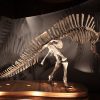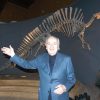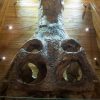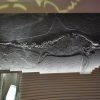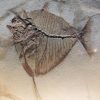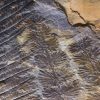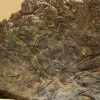Or Palaeontology. Fossils are all that remain of only a small number of the species that lived on the planet. Traces of a journey that lasted millions of years that are brought to light by researchers both to understand the past and to imagine the future.
SEARCHING FOR DINOSAURS. Palaeontology and the Ligabue’s scientific expedition
Buried for millions of years, fossils can be admired and studied thanks to the work of palaeontologists, who are constantly searching for tiles from the vast mosaic of the history of life. It was in this spirit that Giancarlo Ligabue organised an expedition to the Téneré Desert in 1973. Going after the huge skeletons that are rising above the Sahara sands, he uncovered the fossil remains of animals and plants dating back over 100 million years, which included a dinosaur and a giant crocodile.
STONE CREATURES. Testimonies of a lost world
Fossils. The work of the devil or creations of the gods? A joke of nature or the remains of dragons and giants? These “stone creatures” have never ceased to arouse both curiosity and concern, fuelling myths, legends and fanciful hypotheses. In actual fact, fossils are all that remains of countless animal and plant species that followed one another in succession on Earth from the beginnings of time until a few thousand years ago. The fossilisation process is, however, extremely rare and is linked to particular environmental conditions. Fossils are therefore a precious source of information about the natural environments of the past.
THE PATH OF LIFE. The long and complex course of evolution
The Precambrian. This was both the longest and the oldest age, beginning with the origins of the planet itself until just over 500 million years ago. Life rose and developed in the Precambrian: the oldest known fossils, the stromatolites, are around 3.7 billion years old and are the evidence of the activity of primitive single-cell organisms. The first multi-cell beings instead, somewhat similar in shape to modern invertebrates, date back to not more than 670-700 million years ago and are represented by the so-called Ediacara biota.
The Palaeozoic. The Palaeozoic began with the Cambrian period, around 540 million years ago. In fact, a myriad of different life forms, some of which were already highly specialized, suddenly appears in the rocky layers of that age. Most marine invertebrates developed during this period, while the lands above sea level, originally deserted, were colonized first by plants and then by invertebrates, amphibians and reptiles. Towards the end of the Palaezoic, the movements of the continental masses resulted in the formation of one large continent called Pangaea, with the rise of many mountain chains.
The Mesozoic. Known as the “Reptile Era” because of the great development of these vertebrates, the Mesozoic was also the age in which modern dominant groups, such as birds and mammals, originated. The unbelievable similarity among fossils discovered on lands separated by oceans is due to the former existence of one vast continent, the Pangaea. It was only with its later fragmentation that flora and fauna began to differentiate.
The Cenozoic. At the beginning of the Cenozoic, the land arrangement was basically the same as we know it today and the fossils that go back to this period indicate that the climate was relatively hot, with zones characterized by tropical or warm temperate fauna and flora, even in those areas where the climate is much colder today. The disappearance of most of the Mesozoic reptiles created a considerable number of open ecological niches, which were quickly occupied by birds and mammals. The first traces of hominids appeared in the second half of the Cenozoic Era.

